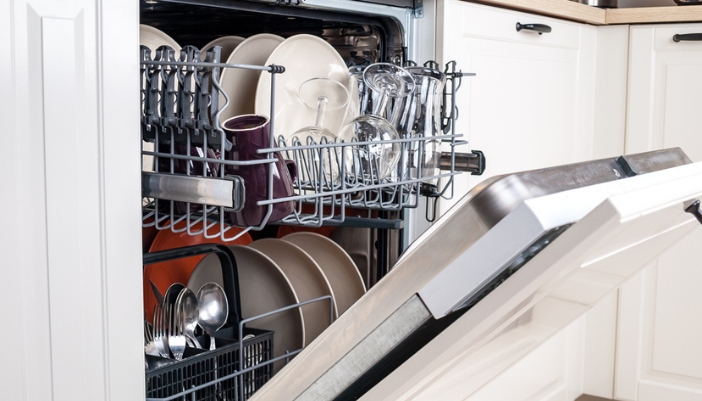You load the dishwasher, press start, and realize, somehow, half the dinner dishes are still sitting on the counter. Sound familiar? It’s one of those everyday frustrations that makes people think, “Maybe it’s time for a larger one.” But here’s the catch: when manufacturers say, “large capacity,” it doesn’t always mean what you expect!
That’s where understanding design, not just size, comes in handy. And if you’re not sure what fits your kitchen or your lifestyle, our experts at Appliance Center can help you compare options and find a model that truly fits the way you live.

How Manufacturers Define “Large Capacity”
That “large capacity” label sounds straightforward, but it’s actually a bit of industry shorthand. Manufacturers don’t measure dishwashers by cubic feet the way they do refrigerators. Instead, they use place settings — a standardized system meant to describe how many dishes fit in one load.
- What counts as a place setting: One dinner plate, salad plate, bowl, drinking glass, cup, saucer, and a full set of utensils. Basically, the dishes from one person’s meal.
- How the rating works: A model listed as “15 place settings” can technically fit fifteen full sets in lab conditions. However, that doesn’t always reflect real-life dishes like oversized mugs, mixing bowls, or baking trays.
- The range to know: Compact dishwashers usually handle 8–10 place settings, standard ones fit around 12–14, and large capacity models are rated for 15–16 or more.
- Why it can be misleading: Those ratings assume ideal spacing and uniform dish sizes, which most households rarely have. So “large” doesn’t always mean it will hold more of your dishes — just that it’s designed to.
Pro Tip:
When comparing models, look at more than the number. Open the door, check the rack spacing, and imagine loading your actual dinnerware — that’s the true test of capacity.

The Design Details That Really Matter
A dishwasher’s true capacity has as much to do with design as it does with size. The smartest models make room where it counts, using adjustable parts and clever rack systems to help you fit more without cramming or crowding.
- Third rack advantage: A slim upper rack offers space for utensils, serving spoons, or small bowls that would otherwise clutter the main racks. Freeing up that lower space instantly boosts usable capacity.
- Fold-down tines: Adjustable or collapsible tines make it easy to fit oddly shaped cookware, from baking sheets to mixing bowls. Flexibility helps customize each load instead of forcing everything into one rigid layout.
- Adjustable middle rack: This feature lets you raise or lower the middle rack to make room for tall stemware or bulky pots below. It’s a simple change that transforms what—and how—you can load.
- Flexible loading zones: Some designs divide the racks into zones that shift or fold independently, so you can rearrange sections to fit your family’s typical dishes. That kind of control often matters more than the total number of place settings.

How Many Dishes Really Fit?
Two dishwashers can both say “large capacity” and perform completely differently once you start loading them. The secret lies in how each model uses its space — not just how much space it claims to have.
| Dishwasher Type | Place Settings | Typical Interior Features | Best For |
|---|---|---|---|
| Compact | 8-10 | Basic racks, limited flexibility | Small households or apartments |
| Standard | 12-14 | Adjustable racks, fold-down tines on some models | Most average-sized families |
| Large Capacity | 15+ | Third rack, flexible zones, height-adjustable middle rack | Busy homes or frequent entertainers |
- Compact models: Great for tight spaces but can fill up quickly, especially if you cook often.
- Standard models: The most common choice, balancing space and efficiency for everyday use.
- Large capacity models: Best suited for families who cook often, entertain, or prefer running fewer loads per week.

Quick Quiz: Do You Really Need a Large Capacity Dishwasher?
Before upgrading, take a minute to think about how your dishwasher actually gets used. These quick questions can help you decide if a larger model makes sense for your kitchen.
- How often do you run your dishwasher? If it’s humming daily—or more than once a day—you’re probably ready for extra space.
- Do you love to cook or bake? Mixing bowls, baking sheets, and big pans eat up room fast, and that’s where larger models shine.
- How many people share your kitchen? Families of four or more will notice the difference between “fits most” and “fits everything.”
- Do you host dinners, holidays, or game nights? Frequent entertaining means bigger loads of plates and glassware after every get-together.
- Would you rather run one full load than two small ones? If efficiency matters more than frequency, capacity will be your best friend.
If you answered “yes” to several of these, that extra rack space is probably worth it. If not, a standard model will keep your kitchen running smoothly without overbuying.
Space to Think About It
Choosing the right dishwasher isn’t really about how much you wash—it’s about how you wash. For some households, a standard model handles the load just fine. For others, those extra racks and fold-down tines make every cleanup smoother and faster.
If you’re still wondering which size is right for you, our experts at Appliance Center are always ready to help. Ask questions, explore features, and see how different layouts look in person. Stop in anytime to shop our full selection and find a dishwasher that actually makes room for your life.
